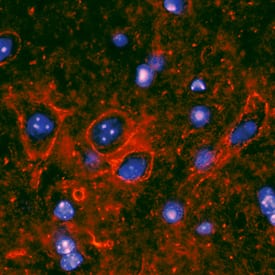Mouse RAGE Antibody
R&D Systems, part of Bio-Techne | Catalog # MAB11794

Key Product Details
Species Reactivity
Applications
Label
Antibody Source
Product Specifications
Immunogen
Gly23-Leu342
Accession # Q62151
Specificity
Clonality
Host
Isotype
Scientific Data Images for Mouse RAGE Antibody
RAGE in Mouse Spinal Cord.
RAGE was detected in perfusion fixed frozen sections of mouse spinal cord using Rat Anti-Mouse RAGE Monoclonal Antibody (Catalog # MAB11794) at 25 µg/mL overnight at 4 °C. Tissue was stained using the NorthernLights™ 557-conjugated Anti-Rat IgG Secondary Antibody (red; Catalog # NL013) and counterstained with DAPI (blue). Specific staining was localized to the plasma membranes of motor neurons. View our protocol for Fluorescent IHC Staining of Frozen Tissue Sections.Applications for Mouse RAGE Antibody
Immunohistochemistry
Sample: Perfusion fixed frozen sections of mouse spinal cord
Reviewed Applications
Read 1 review rated 4 using MAB11794 in the following applications:
Formulation, Preparation, and Storage
Purification
Reconstitution
Formulation
Shipping
Stability & Storage
- 12 months from date of receipt, -20 to -70 °C as supplied.
- 1 month, 2 to 8 °C under sterile conditions after reconstitution.
- 6 months, -20 to -70 °C under sterile conditions after reconstitution.
Background: RAGE/AGER
Advanced glycation endproducts (AGE) are adducts formed by the non-enzymatic glycation or oxidation of macromolecules (1). AGE forms during aging and its formation is accelerated under pathophysiologic states such as diabetes, Alzheimer’s disease, renal failure and immune/inflammatory disorders. Receptor for Advanced Glycation Endoproducts (RAGE), named for its ability to bind AGE, is a multiligand receptor belonging the immunoglobulin (Ig) superfamily. Besides AGE, RAGE binds amyloid beta-peptide, S100/calgranulin family proteins, high mobility group B1 (HMGB1, also know as amphoterin) and leukocyte integrins (1, 2). The mouse RAGE gene encodes a 403 amino acid (aa) type I transmembrane glycoprotein with a 22 aa signal peptide, a 319 aa extracellular domain containing an Ig-like V-type domain and two Ig-like C-type domains, a 21 aa transmembrane domain and a 41 aa cytoplasmic domain (3). The V-type domain and the cytoplasmic domain are important for ligand binding and for intracellular signaling, respectively. Two alternative splice variants, lacking the V-type domain or the cytoplasmic tail, are known (1, 4). RAGE is highly expressed in the embryonic central nervous system (5). In adult tissues, RAGE is expressed at low levels in multiple tissues including endothelial and smooth muscle cells, mononuclear phagocytes, pericytes, microglia, neurons, cardiac myocytes and hepatocytes (6). The expression of RAGE is upregulated upon ligand interaction. Depending on the cellular context and interacting ligand, RAGE activation can trigger differential signaling pathways that affect divergent pathways of gene expression (1, 7). RAGE activation modulates varied essential cellular responses (including inflammation, immunity, proliferation, cellular adhesion and migration) that contribute to cellular dysfunction associated with chronic diseases such as diabetes, cancer, amyloidoses and immune or inflammatory disorders (1).
References
- Schmidt, A. et al. (2001) J. Clin. Invest. 108:949.
- Chavakis, T. et al. (2003) J. Exp. Med. 198:507.
- Renard, C. et al. (1997) Mol. Pharmacol. 52:54.
- Yonekura, H. et al. (2003) Biochem. J. 370:1097.
- Hori, O. et al. (1995) J. Biol. Chem. 270:25752.
- Brett, J. et al. (1993) Am. J. Pathol. 143:1699.
- Valencia, J.V. et al. (2004) Diabetes 53:743.
Long Name
Alternate Names
Gene Symbol
UniProt
Additional RAGE/AGER Products
Product Documents for Mouse RAGE Antibody
Product Specific Notices for Mouse RAGE Antibody
For research use only
